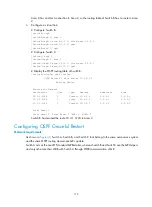
128
IS-IS address format
•
NSAP
As shown in
, an NSAP address consists of the Initial Domain Part (IDP) and the Domain
Specific Part (DSP). The IDP is equal to the network ID of an IP address, and the DSP is equal to the
subnet and host ID.
The IDP includes the Authority and Format Identifier (AFI) and the Initial Domain Identifier (IDI).
The DSP includes the High Order Part of DSP (HO-DSP), System ID, and SEL, where the HO-DSP
identifies the area, the System ID identifies the host, and the SEL identifies the type of service.
The IDP and DSP are variable in length. The length of an NSAP address varies from 8 bytes to 20
bytes.
Figure 49
NSAP address format
•
Area address
The area address comprises the IDP and the HO-DSP of the DSP, which identify the area and the
routing domain. Different routing domains cannot have the same area address.
Typically, a router only needs one area address, and all nodes in the same routing domain must
share the same area address. However, a router can have a maximum of three area addresses to
support smooth area merging, partitioning, and switching.
•
System ID
A system ID identifies a host or router uniquely. It has a fixed length of 48 bits (6 bytes).
The system ID of a device can be generated from the Router ID. For example, a router uses the IP
address 168.10.1.1 of Loopback 0 as the Router ID. The system ID in IS-IS can be obtained in the
following ways:
{
Extend each decimal number of the IP address to 3 digits by adding 0s from the left, like
168.010.001.001;
{
Divide the extended IP address into 3 sections with 4 digits in each section to get the system ID
1680.1000.1001.
If you use other methods for defining a system ID, always make sure that it can uniquely identify a
host or router.
•
SEL
The NSAP Selector (SEL), or the N-SEL, is similar to the protocol identifier in IP. Different transport
layer protocols correspond to different SELs. All SELs in IP are 00.
•
Routing method
Because the area information is identified in IS-IS addresses, a Level-1 router can easily identify
packets destined to other areas.
{
A Level-1 router makes routing decisions based on the system ID. If the destination is not in the
area, the packet is forwarded to the nearest Level-1-2 router.
{
A Level-2 router routes packets across areas according to the area address.
















































